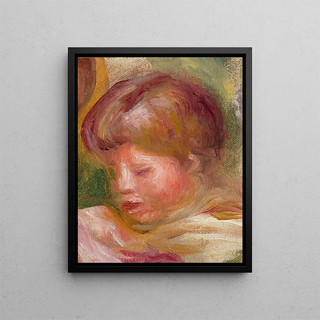Art print | Woman's head - Pierre-Auguste Renoir


View from behind

Frame (optional)
Pierre-Auguste Renoir's "Head of a Woman" presents itself as an open window into the intimacy and feminine beauty of the 19th century. This artwork, both delicate and vibrant, embodies the quintessence of the Impressionist movement, where light and color blend to bring palpable emotions to life. Contemplating this representation, the viewer is transported into a universe where the softness of features and the brightness of hues evoke a delicate sensuality, paying homage to woman in all her splendor. Renoir, through his mastery of nuances and attention to detail, succeeds in capturing not only the physical appearance but also the very essence of his models. The "Head of a Woman" is thus much more than a simple painting; it is a celebration of femininity, an ode to ephemeral beauty.
Style and uniqueness of the work
Renoir's style is distinguished by his ability to seize fleeting moments, to immortalize scenes of life with remarkable lightness and fluidity. In "Head of a Woman," the brushstrokes are both swift and precise, creating a sense of movement that gives the figure a feeling of life. The color palette chosen by the artist, dominated by warm and luminous tones, contributes to the soft, dreamlike atmosphere of the piece. Delicate shadows and bright highlights harmonize beautifully, revealing the subtleties of the female face while also hinting at emotional depth. The way Renoir plays with light, making it almost tangible, is one of the features that make this work so singular. The "Head of a Woman" is not merely a representation but a true exploration of the human soul, inviting the viewer to immerse themselves in the inner universe of the depicted woman.
The artist and his influence
Pierre-Auguste Renoir, an emblematic figure of Impressionism, left a lasting mark on art history through his unique vision and innovative approach. Born in 1841, he established himself as one of the masters of his time, influencing generations of artists worldwide. His ability to capture light

Matte finish

View from behind

Frame (optional)
Pierre-Auguste Renoir's "Head of a Woman" presents itself as an open window into the intimacy and feminine beauty of the 19th century. This artwork, both delicate and vibrant, embodies the quintessence of the Impressionist movement, where light and color blend to bring palpable emotions to life. Contemplating this representation, the viewer is transported into a universe where the softness of features and the brightness of hues evoke a delicate sensuality, paying homage to woman in all her splendor. Renoir, through his mastery of nuances and attention to detail, succeeds in capturing not only the physical appearance but also the very essence of his models. The "Head of a Woman" is thus much more than a simple painting; it is a celebration of femininity, an ode to ephemeral beauty.
Style and uniqueness of the work
Renoir's style is distinguished by his ability to seize fleeting moments, to immortalize scenes of life with remarkable lightness and fluidity. In "Head of a Woman," the brushstrokes are both swift and precise, creating a sense of movement that gives the figure a feeling of life. The color palette chosen by the artist, dominated by warm and luminous tones, contributes to the soft, dreamlike atmosphere of the piece. Delicate shadows and bright highlights harmonize beautifully, revealing the subtleties of the female face while also hinting at emotional depth. The way Renoir plays with light, making it almost tangible, is one of the features that make this work so singular. The "Head of a Woman" is not merely a representation but a true exploration of the human soul, inviting the viewer to immerse themselves in the inner universe of the depicted woman.
The artist and his influence
Pierre-Auguste Renoir, an emblematic figure of Impressionism, left a lasting mark on art history through his unique vision and innovative approach. Born in 1841, he established himself as one of the masters of his time, influencing generations of artists worldwide. His ability to capture light






